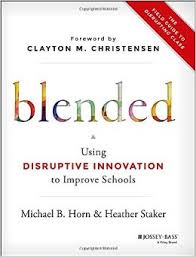I was lucky enough to receive a copy of the book Blended earlier this summer, and as I read it, it only reaffirmed my belief that blended learning has enormous potential in the classroom.
As our society changes from the era of the industrial revolution to the era of the technological revolution, our education system needs to transform as well. With technology, we have the power and capability to personalize student learning–an exciting but also daunting task.
Why daunting? Because we as teachers are forced to shift our paradigms and beliefs about teaching. Most of our experience with learning has been a traditional teacher-centered classroom. That’s how I learned K-12 (and in my college education, for the most part). That’s also how I’ve taught most of my education career. (Admittedly, there are certainly times where direct instruction is important and very effective) So it’s frightening to shift out of our comfort zone of where we’ve learned and taught for so many years.
But the potential that lies in blended learning is too great for me to stay where I am
. https://gaelleguesdon.files.wordpress.com/2012/08/tumblr_m0j5t1zrw11rnr14no1_1280.jpg?w=47
https://gaelleguesdon.files.wordpress.com/2012/08/tumblr_m0j5t1zrw11rnr14no1_1280.jpg?w=47
Blended learning also overwhelms me for the planning and work entailed ahead of time. I’m a huge supporter of student choice and agency, that students shouldn’t have to follow the same path. Yes, they should meet the same standards and objectives, but we can provide for them different paths to do this. However, this also requires planning, organization–and in many ways, this is even more difficult and overwhelming than traditional teaching.
Another issue we may confront is student motivation. Although giving students choice and agency SHOULD be motivating, it’s often not. Students are accustomed to being passive about learning, and it will take time and perseverance to change this. Teachers will still be vital in the classroom, and it will be working with students one-on-one rather than leading entire classes through a lesson; it will also be encouraging students one-on-one to make decisions about learning for themselves rather than telling them exactly what they’ll do.
The more I learn about blended learning, the more inspired, the more motivated, and the more overwhelmed I am. It’s an exciting time to be in education, to be in the classroom. I couldn’t be more energized and exhausted simultaneously than I have been the past year when I’ve started looking into blended learning, gamification, game-based learning, and the Understanding by Design theories.



Leave a Reply